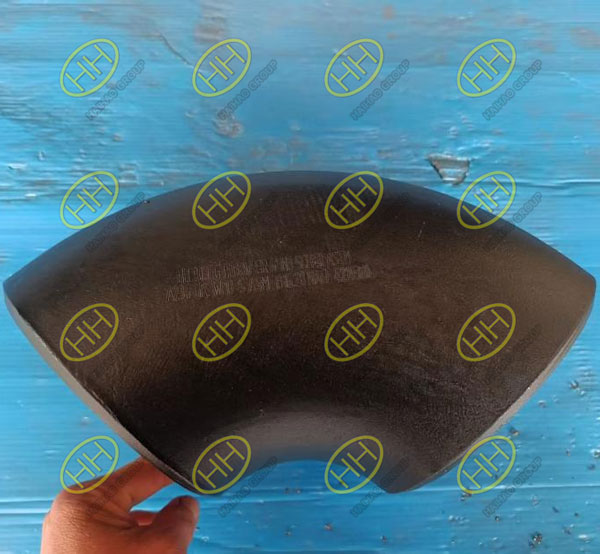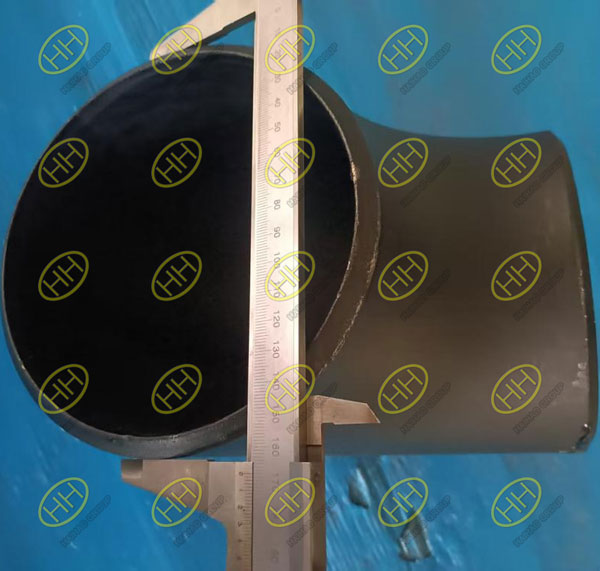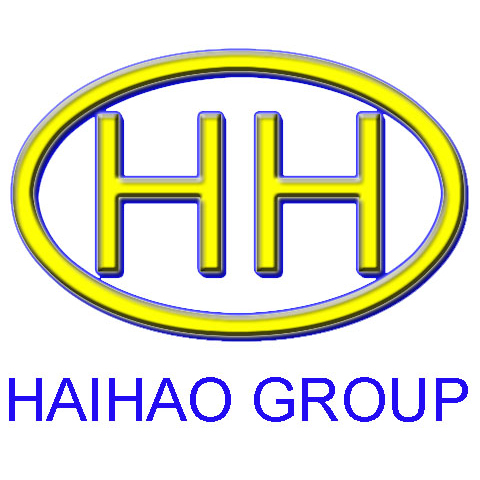ASME B16.28 90° Short Radius Elbow A234 GR.WPB-S with Black Paint – Durable Carbon Steel Fitting for Tight-Space Piping
In industrial piping systems, directional changes are inevitable. When these critical shifts must occur within confined or limited spaces, the ASME B16.28 90° Short Radius (SR) Elbow emerges as an indispensable component. Unlike its long radius counterpart, the short radius elbow’s compact design offers unique advantages and significant application value, making it a cornerstone for efficient and safe fluid transportation in dense layouts. This article will delve into the technical specifications and benefits of this essential pipe fitting, specifically focusing on the A234 GR.WPB-S material and black paint coating. Through professional comparisons and detailed parameter discussions, we’ll illustrate how Haihao Group delivers superior solutions to meet the most demanding industrial requirements.

ASME B16.28 90° Short Radius Elbow A234 GR.WPB-S with Black Paint
2.ASME B16.28 90° Short Radius Elbows: Core Technical Analysis
2.1 Definition and Structural Characteristics
The ASME B16.28 90° Short Radius (SR) Elbow is a pivotal component in industrial piping, designed for situations demanding a sharp, 90-degree change in flow direction within minimal space. The defining feature of an SR elbow is its center-to-end radius, which is equal to the nominal pipe diameter (R = 1D). This ‘1D’ designation signifies its compact nature, as the bending radius is simply one time the pipe’s diameter. In contrast, a Long Radius (LR) Elbow features a radius of 1.5 times the nominal pipe diameter (R = 1.5D).(For detailed differences between the two, please refer to Difference between long radius elbows and short radius elbows)
The ASME B16.28 standard rigorously governs the dimensions, tolerances, wall thicknesses, and inspection protocols for wrought steel buttwelding short radius elbows and returns. Adherence to this standard ensures product interchangeability, structural integrity under specified pressures and temperatures, and consistent performance across diverse applications. It mandates precise manufacturing to ensure these fittings meet the stringent demands of high-pressure, high-temperature fluid conveyance systems.
To illustrate the practical implications, let’s conduct a quantitative comparison between SR and LR elbows:
Specific Applications:
Short Radius Elbows (1D) are ideally suited for applications where space is severely limited, such as in skid-mounted units, compact equipment installations, highly dense piping racks, or scenarios requiring minimal pipeline footprint. They are often found in utility lines, non-critical process lines, and building services where pressure drop is a secondary concern to spatial constraints.
Long Radius Elbows (1.5D) are preferred in systems where smooth flow, minimal pressure loss, and reduced erosion are critical. This includes high-velocity fluid lines, abrasive slurry transport, main process lines, and applications where energy efficiency and long-term pipeline integrity are paramount. They provide a more gradual change in direction, minimizing turbulence and optimizing hydraulic performance.
2.2 Manufacturing Processes and Quality Control
The production of ASME B16.28 90° Short Radius Elbows involves sophisticated manufacturing processes designed to ensure dimensional accuracy, material integrity, and consistent quality. The primary methods include:
Hot Forming (Hot Bending/Hot Induction Bending): This is a common method where pipe sections are heated to a specific temperature and then pushed over a die or mandrel to achieve the desired bend radius. This process is particularly effective for larger diameters and thicker walls, ensuring uniform wall thickness and excellent mechanical properties.
Cold Forming: For smaller diameters or specific applications, cold forming techniques like cold bending or cold drawing might be used. This involves bending the pipe without heating, which can offer tighter tolerances but might require post-forming heat treatment to relieve residual stresses.
At Haihao Group, our commitment to excellence in manufacturing these critical fittings is unwavering. We integrate advanced manufacturing technologies and a rigorous Quality Management System throughout every stage of production:
Precision Tooling and CNC Equipment: We utilize state-of-the-art molds, dies, and Computer Numerical Control (CNC) machinery to ensure highly precise dimensions and consistent geometric accuracy for each elbow. This minimizes variations and guarantees seamless fit-up during installation.
Material Traceability: From raw material sourcing (ASTM A234 GR.WPB-S billets or pipes) to the final product, every component is fully traceable. This comprehensive documentation allows for verification of chemical composition and mechanical properties, ensuring compliance with standards.
Advanced Heat Treatment Control: For A234 GR.WPB-S, the crucial “S” denotes normalized condition. Our controlled normalizing processes optimize the microstructure of the steel, enhancing its toughness, ductility, and resistance to brittle fracture, particularly vital for high-pressure and high-temperature applications.
Comprehensive Non-Destructive Testing (NDT): Before dispatch, all our elbows undergo a series of stringent inspections, which may include:
Visual Inspection: For surface imperfections and dimensional accuracy.
Magnetic Particle Testing (MPT) or Liquid Penetrant Testing (LPT): To detect surface and near-surface discontinuities.
Ultrasonic Testing (UT) or Radiographic Testing (RT): For internal flaws and wall thickness uniformity, ensuring complete structural integrity.
Hydrostatic Testing: Though not always mandatory for fittings alone, we ensure our elbows are capable of withstanding specified test pressures, confirming their leak-proof performance under operational conditions.
This meticulous approach to manufacturing and quality control ensures that every ASME B16.28 90° Short Radius Elbow from Haihao Group not only meets but often exceeds the industry’s most demanding performance and reliability requirements.
3.Material Deep Dive: The Exceptional Performance of ASTM A234 GR.WPB-S
3.1 ASTM A234 GR.WPB-S Material Characteristics Explained
The selection of appropriate material is paramount for the integrity and longevity of any piping system, particularly for components like elbows that manage directional flow changes. ASTM A234 Grade WPB-S is a widely specified carbon steel material for buttwelding fittings, renowned for its suitability in moderate to high-temperature service. Let’s break down its composition and mechanical prowess:
Chemical Composition Analysis: The robust performance of A234 GR.WPB-S is rooted in its carefully controlled chemical composition. While exact percentages vary slightly by heat, the key elements typically fall within these approximate ranges (refer to ASTM A234 standard for precise limits):
Carbon (C): Typically up to 0.30%. Carbon is the primary hardening element in steel, contributing to tensile strength. Higher carbon content generally increases strength but can reduce ductility and weldability.
Manganese (Mn): Up to 1.06%. Manganese improves strength, hardness, and wear resistance, and acts as a deoxidizer during steelmaking. It also enhances the steel’s response to heat treatment.
Silicon (Si): Up to 0.35%. Silicon acts as a deoxidizer and can improve strength and hardness.
Sulfur (S): Max 0.050%. Kept low, as sulfur forms brittle iron sulfides, reducing ductility and toughness.
Phosphorus (P): Max 0.050%. Also kept low, as phosphorus can cause cold shortness (embrittlement at low temperatures).
Other elements (e.g., Chromium, Nickel, Molybdenum, Vanadium, Copper, Niobium): Controlled trace amounts or specific additions for enhanced properties, depending on manufacturing specifics, within total limits.
3.2 Suitable Operating Conditions and Media Compatibility
ASTM A234 GR.WPB-S elbows are highly versatile and engineered to perform reliably across a spectrum of industrial conditions. Their robust mechanical properties, particularly after the normalizing heat treatment, make them exceptionally well-suited for:
a.High-Pressure Environments: Capable of handling significant internal pressures, making them ideal for transmission pipelines, pressure vessels, and high-pressure process systems.
b.Moderate to High-Temperature Service: They maintain their mechanical integrity and strength at elevated temperatures typically found in steam lines, chemical processing, and power generation plants. While excellent, it’s crucial to adhere to ASME B31 pressure piping codes for specific temperature limits.
c.Dynamic and Stressful Conditions: The improved toughness from normalizing helps the material withstand thermal cycling, pressure fluctuations, and minor stresses that could otherwise lead to fatigue or brittle failure in less robust materials.
Media Compatibility: These fittings are widely compatible with a broad range of common industrial media, including:
a.Oil & Gas: Suitable for crude oil, refined petroleum products, natural gas (both dry and wet conditions), and various hydrocarbon streams.
b.Water: Applicable for potable water, industrial water, cooling water systems, and wastewater treatment, including steam condensate lines.
c.Steam: Excellent for high-pressure and high-temperature steam lines in power generation and industrial heating.
d.Air & Inert Gases: Used in compressed air systems and inert gas distribution networks.
e.Non-Corrosive Chemicals: Capable of handling various non-corrosive chemical solutions, depending on concentration, temperature, and specific chemical properties.
Corrosion Resistance with Black Paint Coating
While A234 GR.WPB-S is a carbon steel and inherently susceptible to corrosion in aggressive environments, the black paint coating applied by Haihao Group provides an essential layer of basic rust prevention. This coating is primarily designed for:
Protection during Storage and Transit: Safeguarding the fittings from atmospheric corrosion before installation.
Non-Corrosive or Moderately Corrosive Environments: Suitable for indoor applications, systems with additional insulation, or those where external protection is not highly critical.
Cost-Effective Initial Protection: Offers a practical solution for projects where the primary long-term corrosion protection will be handled by external wrapping, insulation, or a controlled operating environment.
For highly corrosive environments or buried applications, additional robust anti-corrosion coatings (e.g., FBE, 3LPE) or cathodic protection systems would be specified, which Haihao Group can also provide as optional surface treatments. The combination of the resilient A234 GR.WPB-S material and the protective black paint ensures reliable performance and extended service life within its intended application scope.

Quality inspection of ASME B16.28 90° Short Radius Elbow A234 GR.WPB-S with Black Paint
4.Why Choose Haihao Group: Our Commitment to Quality, Expertise, and Service
Choosing the right partner for your piping components is crucial for project success and long-term operational integrity. At Haihao Group, we don’t just supply fittings; we deliver a promise of unwavering quality, deep technical expertise, and comprehensive customer service.
4.1Core Competencies & Robust Quality Systems
Haihao Group’s reputation as a leading manufacturer of pipe fittings is built on our rigorous adherence to international standards and decades of accumulated experience. We enforce strict compliance with both ASME B16.28 for buttwelding short radius elbows and ASTM A234 for carbon steel fittings, ensuring every product meets the highest benchmarks for dimensional accuracy, material composition, and performance.
Our commitment to excellence is deeply embedded in our Quality Control (QC) processes:
Full Lifecycle Traceability: We implement a comprehensive traceability system that spans from raw material procurement to the final finished product. Every component can be tracked back to its origin, providing unparalleled transparency and accountability. This means you can verify the chemical composition, mechanical properties, and manufacturing history of each fitting, ensuring complete peace of mind.
Third-Party Inspection Qualifications: To further validate our quality, we regularly engage reputable third-party inspection agencies. Their independent verification and certification affirm that our products consistently meet or exceed specified industry standards and customer requirements.
Beyond stringent QC, our production capabilities and technical prowess set us apart:
Advanced Production Lines: Our state-of-the-art manufacturing facilities are equipped with cutting-edge machinery, including precision forming equipment, automated welding stations, and advanced heat treatment furnaces. This ensures high efficiency, consistent quality, and the capacity to handle large-scale orders.
Expert Engineering Team: Our dedicated team of professional engineers brings extensive knowledge and experience in metallurgy, piping design, and manufacturing processes. They oversee every stage of production, conduct continuous R&D to innovate product performance, and are available to provide expert technical consultation.
4.2 Customized Solutions & Global Service Excellence
We understand that every project has unique requirements. Haihao Group distinguishes itself by offering non-standard customization capabilities, allowing us to design and manufacture fittings tailored precisely to your specific dimensions, materials, or application needs. Whether it’s a unique radius, a specialized wall thickness, or a particular surface treatment, our engineering team works closely with you to transform your specifications into high-performance realities.
Our commitment extends far beyond manufacturing:
Global Delivery Network: With a robust and efficient global logistics network, we ensure timely and secure delivery of your orders, regardless of your geographical location. We streamline the shipping process to minimize lead times and logistical complexities.
Comprehensive Pre- and After-Sales Technical Support: From initial inquiry to post-installation, Haihao Group provides extensive technical support. Our knowledgeable team offers expert guidance on product selection, material compatibility, installation best practices, and troubleshooting. We act as your reliable partner, providing continuous support to ensure the seamless integration and optimal performance of our fittings within your piping systems.
At Haihao Group, we’re not just about selling products; we’re about forging lasting partnerships built on trust, quality, and an unwavering dedication to your success.
Contact us today for detailed specifications or a quotation for your project. Email:sales@haihaogroup.com

